A foundational principle of integrated pest management (IPM) in urban landscapes is to put the right plant in the right place. This preventive tactic can reduce plant stress, pest infestations, and subsequent pesticide applications. This publication focuses on selecting red maple planting sites that will help reduce tree stress and scale insect pests by maximizing surfaces permeable to water.
Determining the "Right Place" to Plant Red Maples
Many urban tree species have more insect and mite pests in urban landscapes than in surrounding natural areas. This is due in part to stress created by impervious surfaces such as roads and sidewalks that can increase air temperature and reduce soil moisture. For red maples (Acer rubrum), more impervious surface area leads to more stress and worse tree condition. To reduce stress and maintain trees in good condition you need to:
- Measure the amount of impervious surface at the planting site.
- Use impervious surface thresholds to decide whether the site can support a mature red maple.
Impervious Surface Thresholds
In IPM, thresholds are established points beyond which pest damage is likely to occur if managers do not act to prevent it. Impervious surface cover within a 25m radius of a tree or planting site will affect the tree's temperature, drought stress, pest abundance, and condition. Thus, impervious surface thresholds have been developed as tools to aid decision making when designing urban landscapes that will include plantings of red maples. They tell you how much impervious surface is too much.
Arborists and other tree-care professionals commonly rate tree condition as poor, fair, good, or excellent based on several metrics of tree health (e.g., canopy density, dieback, trunk health, leaf condition, etc.). Impervious surface thresholds are based on the relationship between the amount of impervious surface cover and arborist-assigned tree condition ratings in cities throughout southern and mid-Atlantic states. Landscape architects, urban planners, arborists, landscapers, and others can use these thresholds to increase red maple longevity and reduce management and replacement costs.
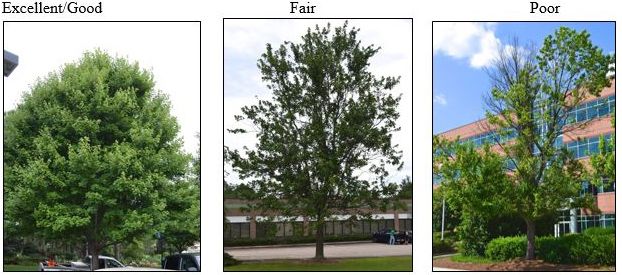
Credit: Adam G. Dale, UF/IFAS
The Thresholds
Based on data from across the eastern United States, we developed two thresholds of impervious surface that generally ensure three categories of condition for urban red maple trees. Trees planted with 0–36% impervious surface cover with a 25m radius are most likely to be in good or even excellent condition. These are sites where red maple planting is appropriate. Trees planted with 36–61% impervious surface cover at 25m radius are most likely to be in fair condition. Unless there are other factors like irrigation to help the trees, we do not recommend planting red maples in these sites. Trees planted in sites with over 61% impervious surface cover at 25m radius are destined to be in poor condition. Red maples should not be planted in these locations.
The Effect of Geographic Location on Impervious Surface Thresholds
We have quantified impervious surface thresholds for red maples throughout the eastern United States where red maples are among the most common urban tree species. We found that impervious surface thresholds do not change considerably depending on the geographic location from Newark, DE (northernmost) to Gainesville, FL (southernmost).
How to Measure Impervious Surface Cover
To implement impervious surface thresholds, you need to measure the percent of impervious surface cover within a 25m-radius circle around your tree or planting site. Impervious surface cover can be measured from satellite images or landscape plans with computer software such as ArcGIS or AutoCad. On site, you can measure impervious surface cover using the Pace to Plant technique.
The Pace to Plant Technique
Landscape professionals who are installing trees can use these thresholds to increase the likelihood the new trees will survive and thrive after planting. Because computer software and analysis is not practical for on-the-ground use, a site-assessment technique is useful. The Pace to Plant technique is a tool for landscape professionals to quickly and accurately quantify the amount of impervious surface surrounding a tree or planting site. Simply follow five steps to estimate the percentage of impervious surface area covering the ground around a planting site.
Step 1. Beginning at the planting site, take 25 steps at 45° to the nearest impervious edge, counting the steps that land on impervious surface (white footsteps in Figure 2).
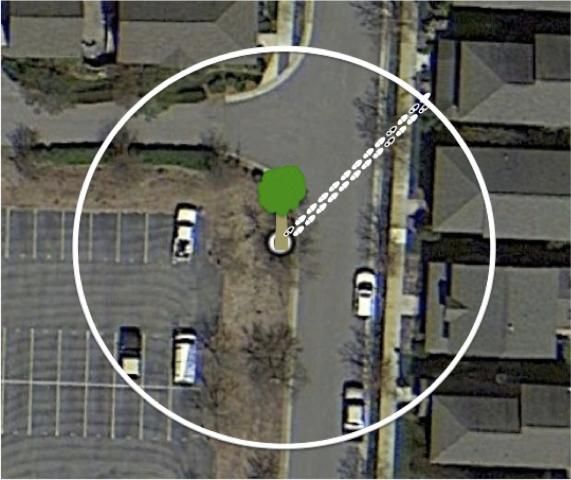
Credit: Adam G. Dale, UF/IFAS
Step 2. Take 25 more steps at 90° to the previous starting point, counting the steps that fall onto impervious surface (white footsteps in Figure3 ).
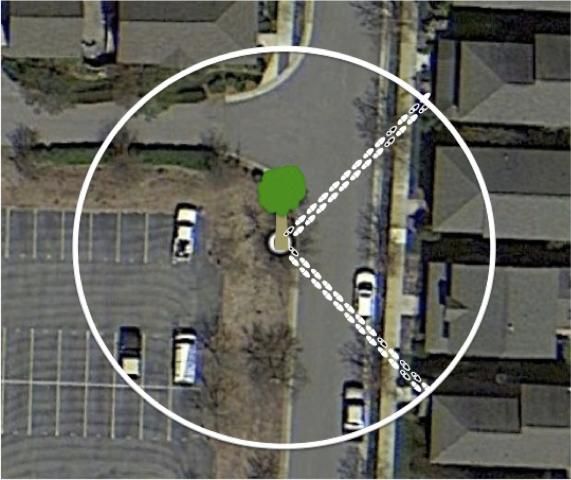
Credit: Adam G. Dale, UF/IFAS
Step 3. Take 25 more steps at 90° to the previous starting point, counting the steps that fall onto impervious surface (white footsteps in Figure 4).
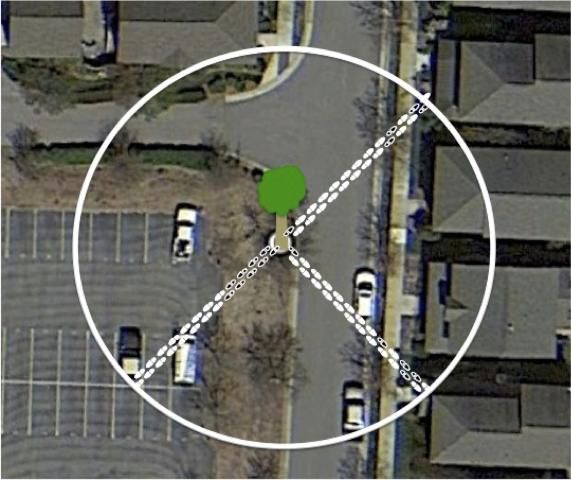
Credit: Adam G. Dale, UF/IFAS
Step 4. Take 25 more steps at 90° to the previous starting point, counting the steps that fall onto impervious surface (white steps in Figure 5). This is the final leg, making an X through the planting site and totaling 100 steps taken.
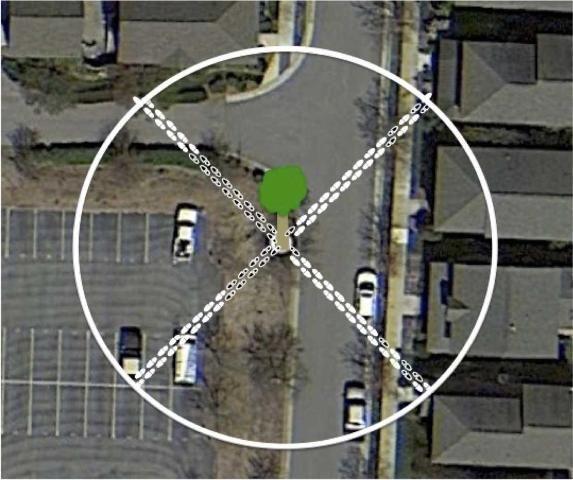
Credit: Adam G. Dale, UF/IFAS
Step 5. Count the steps. The total number of steps that fall onto impervious surface equals the percentage of the surrounding ground area that is impervious to water. Using the impervious surface thresholds, this percentage can guide tree selection decisions. In step 4, 66/100 white footsteps landed on impervious surface, meaning that 66% of the area within the circle is impervious. Satellite imagery calculations also determined that 66% of the circle was composed of impervious surfaces.
Summary
As cities expand and habitats transition from natural to urban, landscapes must be designed using guidelines that maximize plant survival and services. Trees that live longer, grow larger, and harbor fewer damaging pests, cost less to maintain, and provide more benefits to people and the environment. Impervious surface thresholds and the Pace to Plant technique together provide an approach to this informed decision-making that will allow more large, long-lived trees to thrive in urban spaces.
References
Dale, A. G., and S. D. Frank. 2017. "Warming and Drought Combine to Increase Pest Insect Fitness on Urban Trees." PLoS ONE 12(3): e0173844. doi:10.1371/journal.pone.0173844.
Dale, A. G., E. Youngsteadt, and S. D. Frank. 2016. "Forecasting the Effects of Heat and Pests on Urban Trees: Impervious Surface Thresholds and the 'Pace to Plant' Technique." Arboriculture & Urban Forestry 42(3) 181–191.
Dale, A. G., and S. D. Frank. 2014. "Urban Warming Trumps Natural Enemy Regulation of Herbivorous Pests." Ecological Applications http://dx.doi.org/10.1890/13–1961.1
Dale, A. G., and S. D. Frank. 2014. "The Effects of Urban Warming on Herbivore Abundance and Street Tree Condition." PLoS ONE 9(7): e102996. DOI: 10.1371/journal.pone.0102996